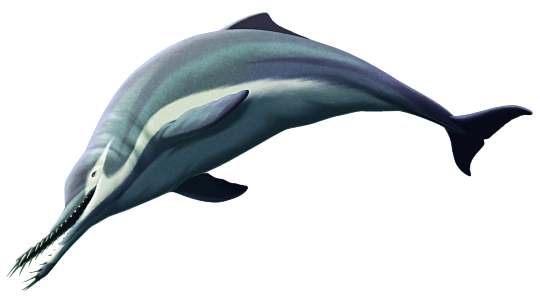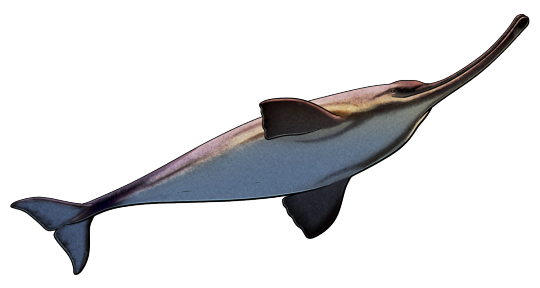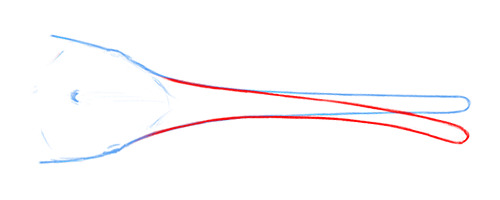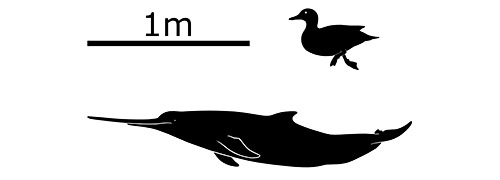#fat torpedoes who scream to navigate
Text

Nihohae matakoi was a dolphin that lived in the coastal waters around what is now Aotearoa New Zealand during the late Oligocene, about 25 million years ago. Part of a group known as waipatiids, it was much closer related to modern South Asian river dolphins than to modern oceanic dolphins.
Around 2m long (6'6"), it had unusually long tusk-like teeth at the front of its jaws, splaying out almost horizontally forwards and to the sides.
These teeth lay too flat to effectively interlock as a "fish trap", and their fairly delicate structure and lack of wear marks suggests they also weren't used for piercing large prey, sifting through gritty sediment, defending against predators, or for fighting each other. But Nihohae did have a highly flexible neck and the ability to quickly snap its jaws from side to side – although with a relatively weak bite force, suggesting it was primarily tackling small soft-bodied prey that could be easily swallowed whole.
Overall its feeding ecology seems to have been similar to modern sawfish, stunning prey such as squid with rapid slashing swipes of its jaws.
———
NixIllustration.com | Tumblr | Twitter | Patreon
#science illustration#paleontology#paleoart#palaeoblr#nihohae#waipatiidae#platanistoidea#dolphin#odontoceti#toothed whale#cetacean#whale#mammal#marine mammal#art#teeth#it's weird dolphin hours#fat torpedoes who scream to navigate
492 notes
·
View notes
Text

Strange Symmetries #19: Wonky Whales
Toothed whales – the branch of cetaceans that includes modern dolphins, porpoises, beaked whales, and sperm whales – have surprisingly asymmetrical skulls, with some of the bones skewed to one side and just the left nostril forming their blowhole.
Some of the most obvious external manifestation of this lopsidedness can be seen in sperm whales, which have their blowhole at the front left side of their head, and in male narwhals, which usually have a single left-side tusk.
This sort of asymmetry first appeared in the skulls of early toothed whales around 30 million years ago. And since the highest amounts of wonkiness have gone on to develop in lineages that hunt in dark, cluttered, or murky waters, this suggests that the trait is somehow linked to the evolution of complex echolocation.
Some ancient members of the river dolphin lineage also had some additional unusual asymmetry, sometimes having slightly sideways-bending snouts.
Ensidelphis riveroi was one of the weirdest of these, living around the coasts of what is now Peru during the Miocene, about 19 million years ago. Around 3m long (~10'), it had a very long narrow toothy snout that curved distinctly off to the right along its length.

It's not clear what the function of this bend was, or even if the only known skull actually represents the normal condition for this species. But Ensidelphis' bendy snoot might have been used to probe around in muddy seafloor sediment or to extract prey from crevices, possibly like an underwater version of the modern wrybill.
———
NixIllustration.com | Tumblr | Twitter | Patreon
#science illustration#strange symmetries#paleontology#paleoart#palaeoblr#ensidelphis#platanistoidea#river dolphin#odontoceti#toothed whale#cetacean#whale#artiodactyla#ungulate#mammal#marine mammal#art#side-snouted dolphin#it's weird dolphin hours#fat torpedoes who scream to navigate
350 notes
·
View notes
Photo

Weird Heads Month #19: Sword-Snouted Whales
Cetaceans are just weird animals in general. Fully aquatic mammals best described as "fat screaming torpedoes", with bizarre head anatomy and their nostrils pulled up to the top of their heads behind their eyes. Some of them are among the largest animals to ever exist, some of them can live to over 200 years old, and some can dive to incredible depths below the ocean surface.
And they're all descended from tiny deer-like creatures, with their closest living relatives being hippos and other even-toed ungulates.
Some ancient cetaceans were particularly odd-looking, evolving walrus-like tusks or elongated chins – or in the case of Eurhinodelphis longirostris here, an incredibly long swordfish-like snout.
Living during the mid to late Miocene, about 14-7 million years ago, Eurhinodelphis ranged across the Mediterranean and the North Atlantic, with fossil remains known from Western Europe, Turkey, and the East Coast of the United States. It was a fairly small dolphin-like cetacean about 2m long (6'6"), and was part of a lineage of early toothed whales called eurhinodelphinids.
Its upper jaw was around five times longer than the rest of its skull, and toothless past the point where the lower jaw ended. Much like the modern billfish it resembled, it probably used its snout to slash at fast-moving fish, stunning them and making them easier to catch.

———
Nix Illustration | Tumblr | Pillowfort | Twitter | Patreon
#weird heads 2020#science illustration#paleontology#paleoart#palaeoblr#eurhinodelphis#eurhinodelphinidae#odontoceti#toothed whale#cetacean#whale#artiodactyla#ungulate#mammal#art#marine mammal#fat torpedoes who scream to navigate#that is an excellent snoot
524 notes
·
View notes